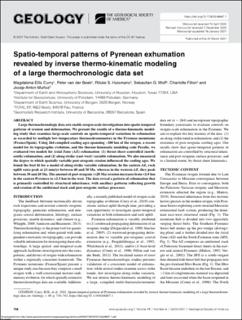Spatio-temporal patterns of Pyrenean exhumation revealed by inverse thermo-kinematic modeling of a large thermochronologic data set
Curry, Magdalena Ellis; van der Beek, Peter; Huismans, Ritske Sipke; Wolf, Sebastian Georg; Fillon, Charlotte; Muñoz, Josep Anton
Journal article, Peer reviewed
Published version

Åpne
Permanent lenke
https://hdl.handle.net/11250/2988307Utgivelsesdato
2021Metadata
Vis full innførselSamlinger
- Department of Earth Science [1034]
- Registrations from Cristin [9489]
Sammendrag
Large thermochronologic data sets enable orogen-scale investigations into spatio-temporal patterns of erosion and deformation. We present the results of a thermo-kinematic modeling study that examines large-scale controls on spatio-temporal variations in exhumation as recorded by multiple low-temperature thermochronometers in the Pyrenees mountains (France/Spain). Using 264 compiled cooling ages spanning ∼200 km of the orogen, a recent model for its topographic evolution, and the thermo-kinematic modeling code Pecube, we evaluated two models for Axial Zone (AZ) exhumation: (1) thrust sheet–controlled (north-south) exhumation, and (2) along-strike (east-west) variable exhumation. We also measured the degree to which spatially variable post-orogenic erosion influenced the cooling ages. We found the best fit for a model of along-strike variable exhumation. In the eastern AZ, rock uplift rates peak at ≥1 mm/yr between 40 and 30 Ma, whereas in the western AZ, they peak between 30 and 20 Ma. The amount of post-orogenic (<20 Ma) erosion increases from <1.0 km in the eastern Pyrenees to >2.5 km in the west. The data reveal a pattern of exhumation that is primarily controlled by structural inheritance, with ancillary patterns reflecting growth and erosion of the antiformal stack and post-orogenic surface processes.
